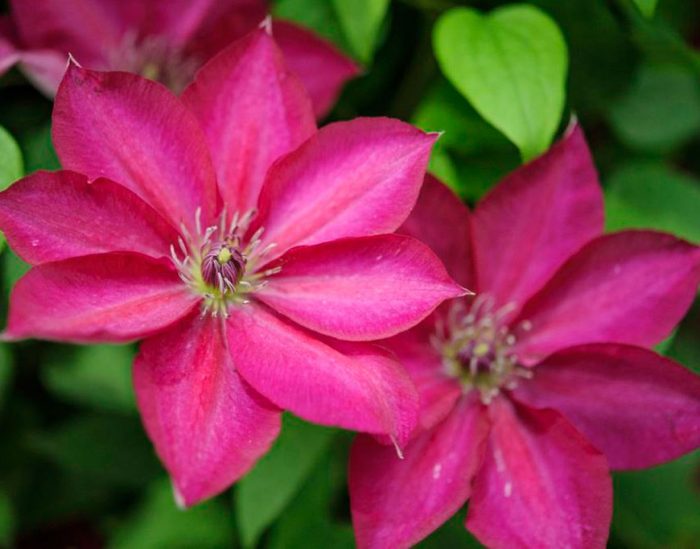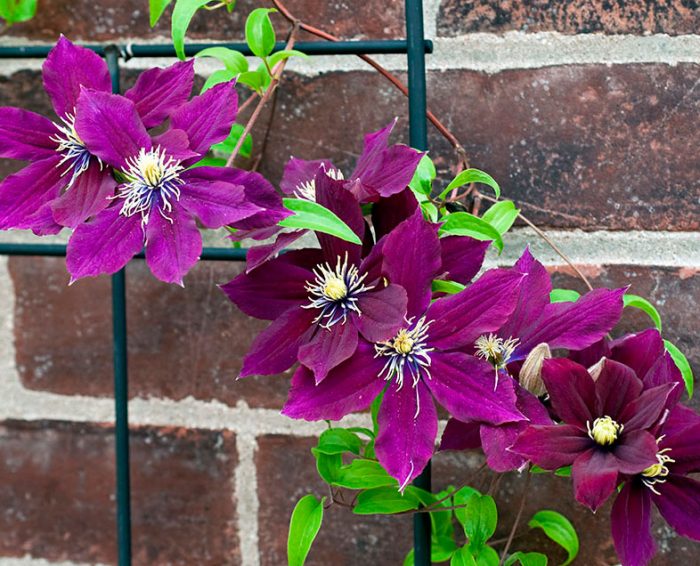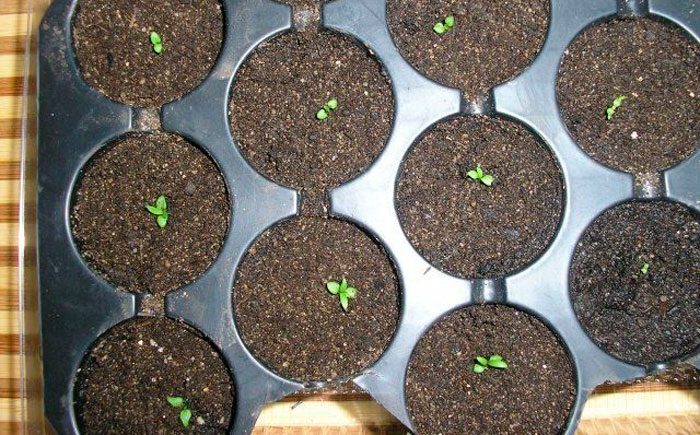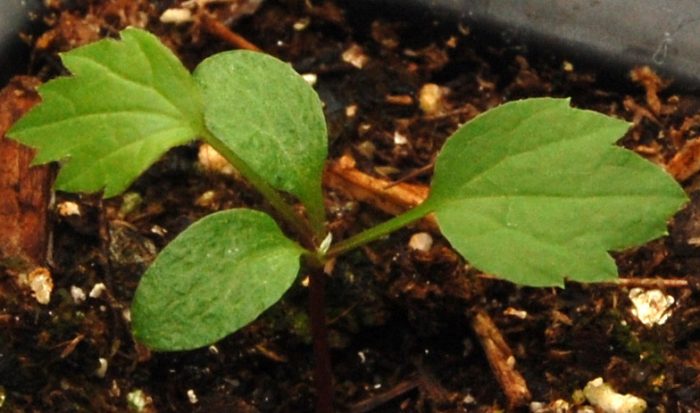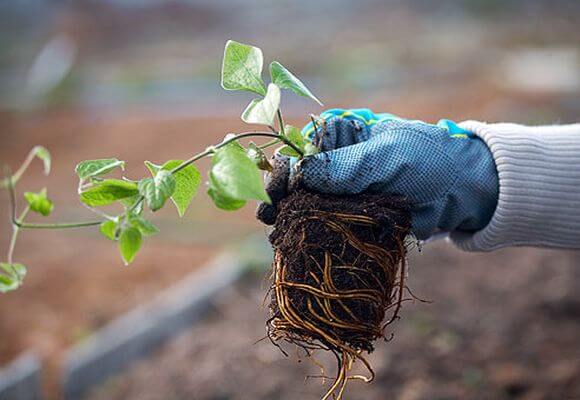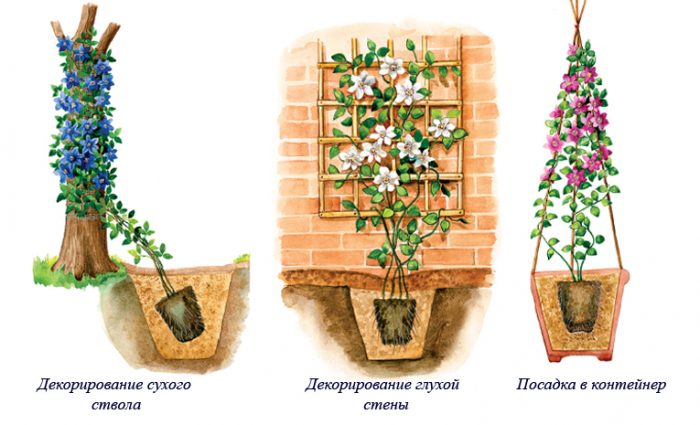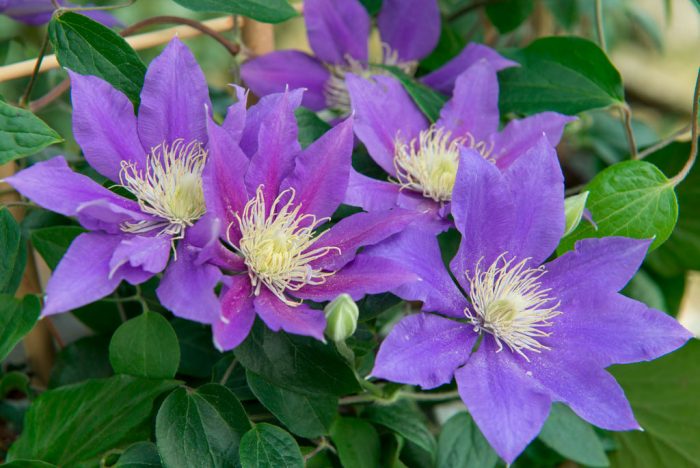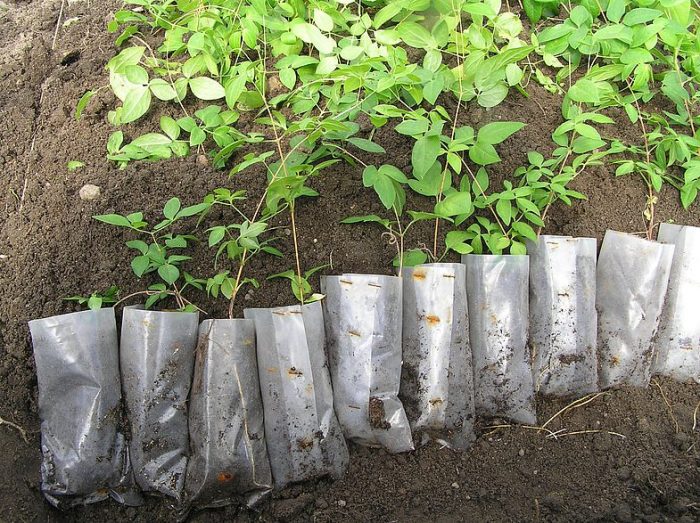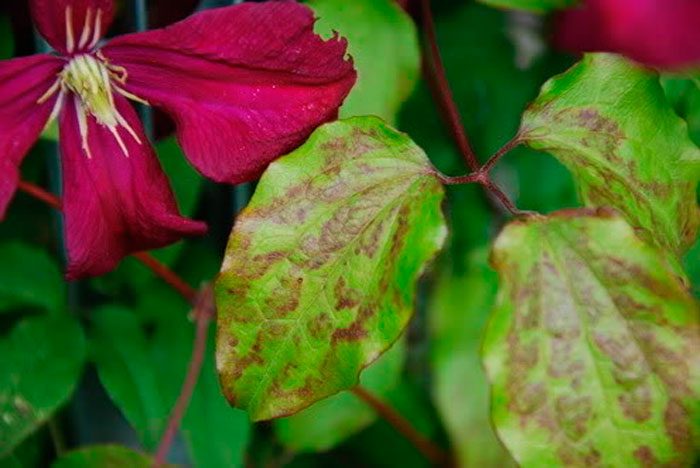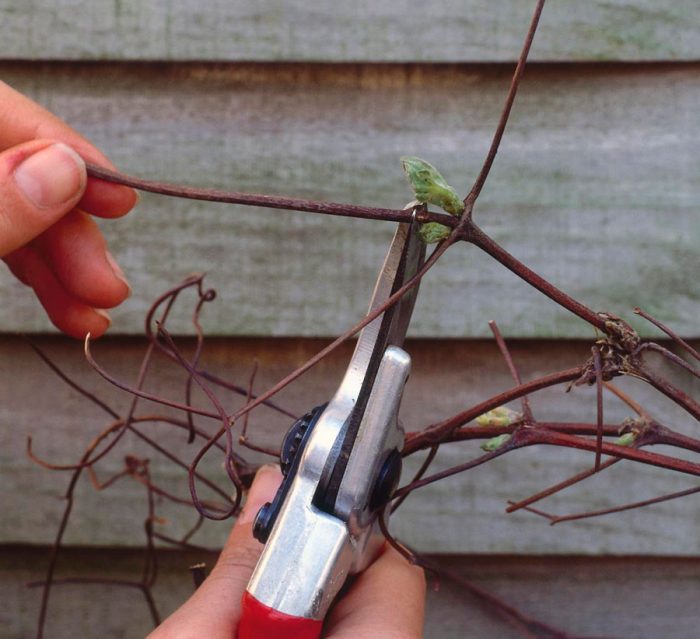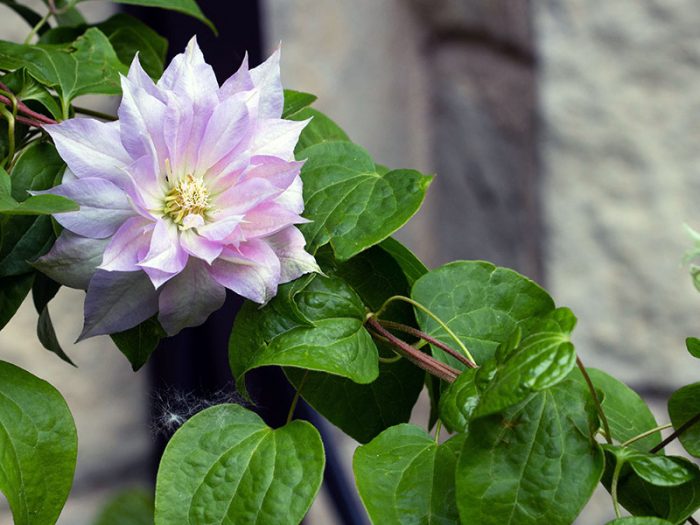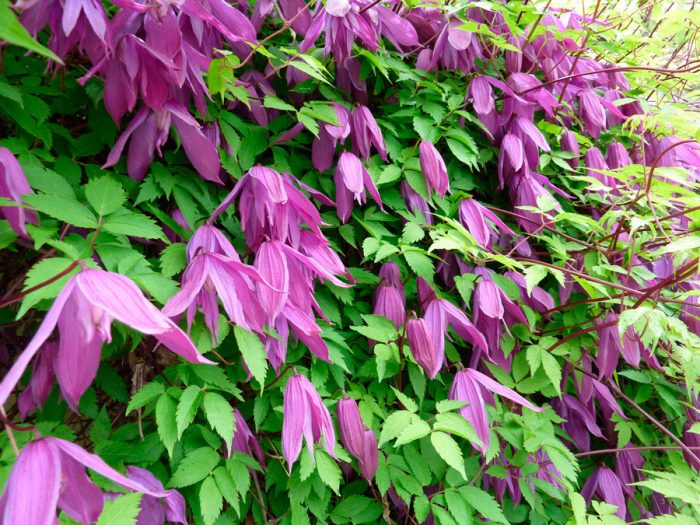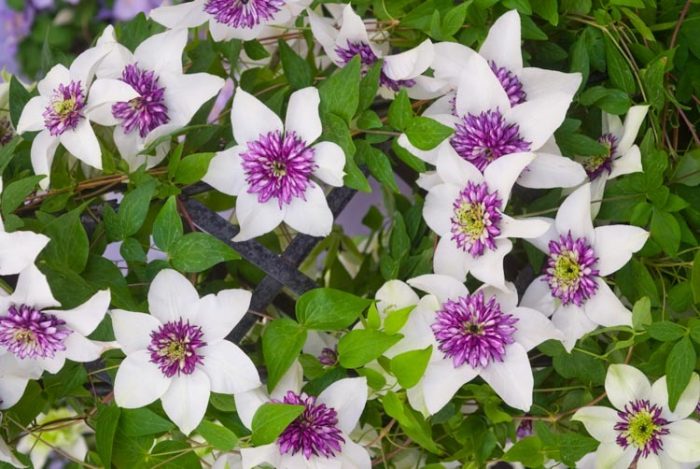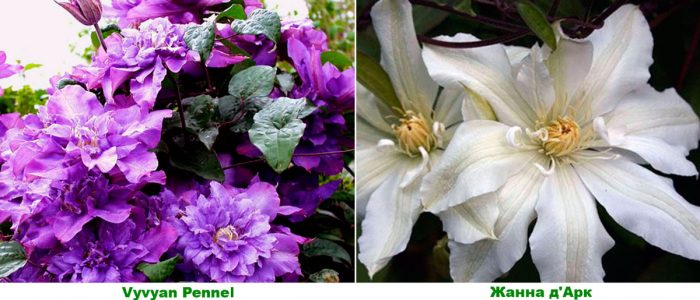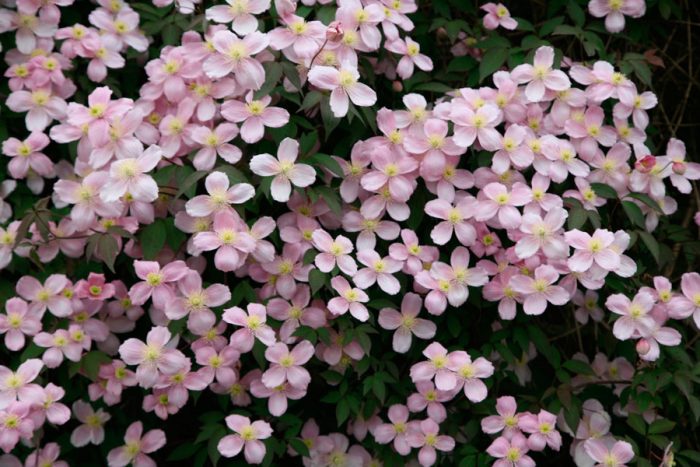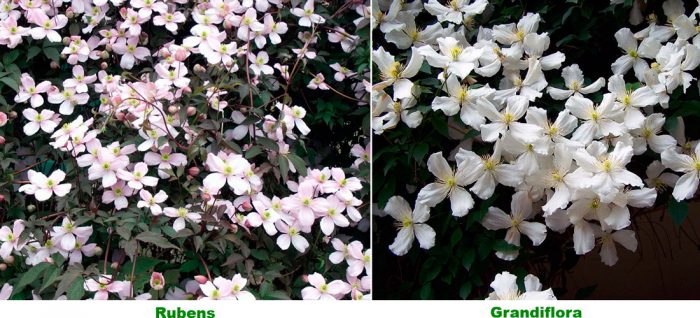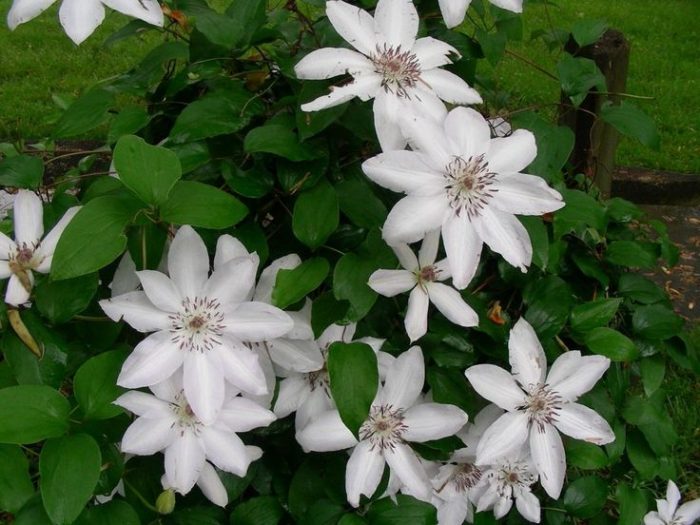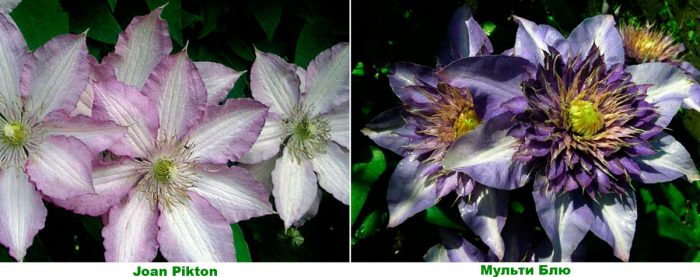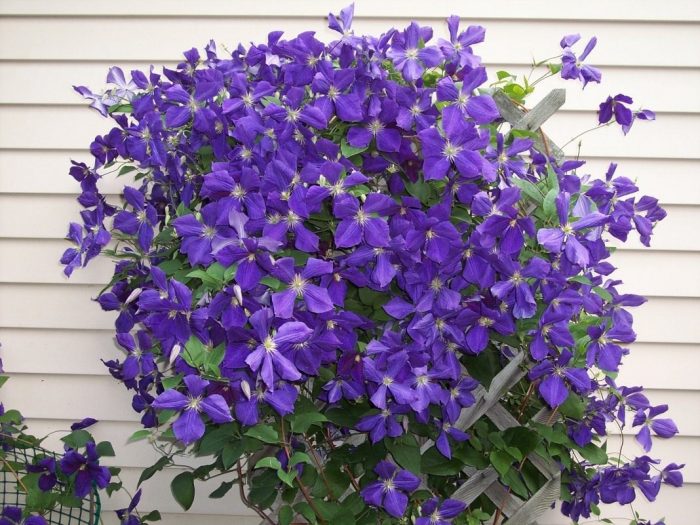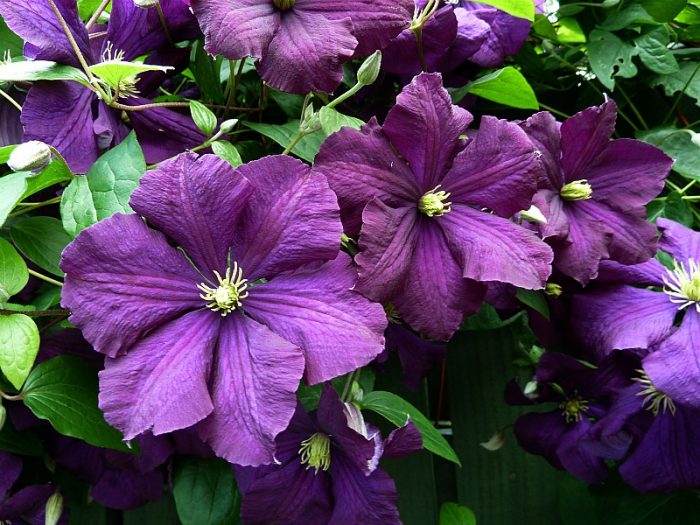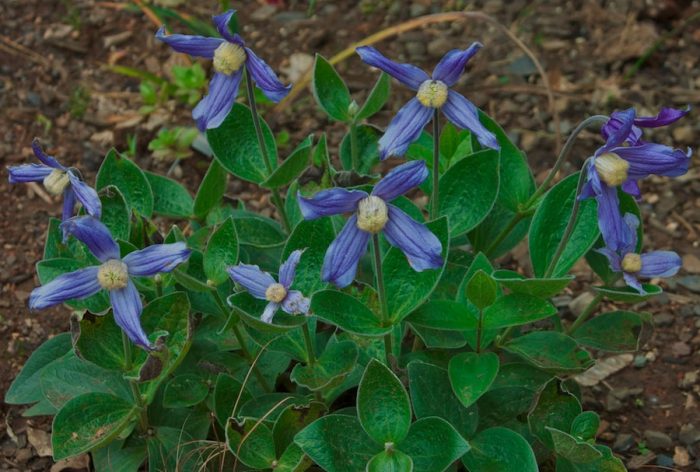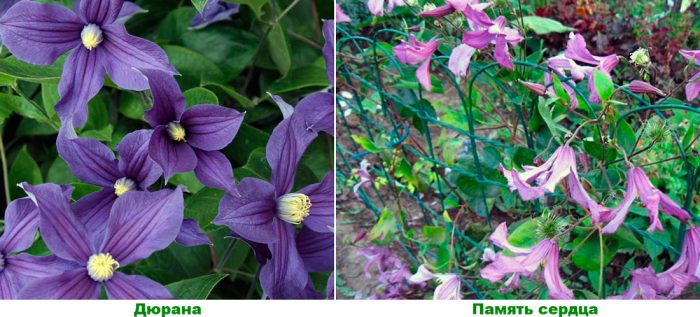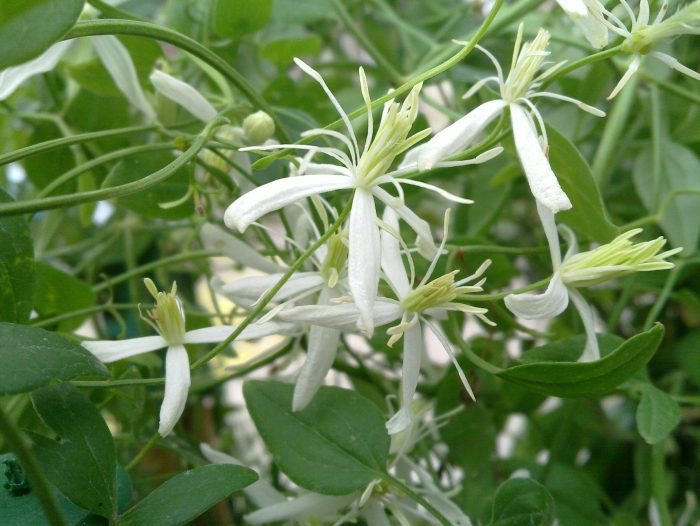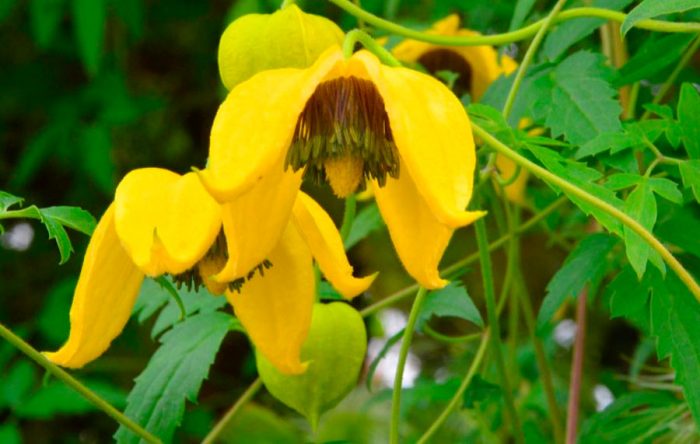Clematis (Clematis), also called a vine, or clematis, is a genus belonging to the Buttercup family. Clematis is represented by herbaceous perennials or woody plants. In nature, they can be found in the subtropical or temperate zone of the Northern Hemisphere. This genus unites about 300 species, which often have very strong differences when compared with each other. "Klema" is the Greek word used to refer to any climbing plant. In floriculture, clematis liana is the most popular. Some growers claim that this plant can replace a whole garden.
Content
Features of clematis
Different types of clematis differ greatly among themselves. This culture is represented by shrubs, semi-shrubs, herbaceous plants, but most of the species are vines. Clematis has 2 types of root system: fibrous and pivotal (such plants do not tolerate transplanting well). The stems of the current season are thin, in woody species these shoots are faceted, and in herbaceous ones they are round and green in color. The development of such shoots occurs from the aboveground buds of old stems or from the underground part of the bush. Leaf plates are simple or complex (they include 3, 5 or 7 leaves), they are paired. Typically, the foliage is green, but there are species with purple leaves. The flowers are bisexual, they are part of the inflorescences, which can be corymbose, semi-umbellate or panicle-shaped. There are species with single flowers. The petals are actually sepals, there can be 4-8 of them on a flower. Double flowers have up to 70 petals. Simple flowers in the central part have a large number of pistils and stamens, due to which the middle is outwardly similar to a hairy spider, while it often has a contrasting color. Flowers can be painted in a wide variety of color shades: from velvet blue to bluish, from dark red to pinkish, there are also types with white and yellow colors. The life span of one flower is 15 to 20 days. Most varieties have a smell similar to jasmine, primrose or almond. The fruit is a large number of achenes.
Growing clematis from seeds
Sowing seeds
Since there are a lot of species and varieties of clematis, some gardeners also decide to start breeding it. To do this, you just need to grow this plant from the seed. All clematis are divided into 3 groups according to the size of the seeds and the duration of their germination:
- Clematis, which have large seeds that germinate unevenly and for a long time (from 1.5 to 8 months, and sometimes longer). For example: clematis of Duran, Jacqueman, purple, woolly and others.
- Clematis has medium-sized seeds that can take 1.5 to 6 months to germinate. For example: clematis whole-leaved, Manchurian, six-petal, Douglas, Chinese, etc.
- Clematis with small seeds, which are characterized by friendly and fast germination (from 2 to 16 weeks). For example: clematis Tangut, grape-leaved, etc.
Seeds harvested in the current season germinate faster and best. However, if the seeds are placed in paper bags for storage and placed in a place where the temperature is 18-23 degrees, they will retain their germination capacity for up to 4 years.
It should also be remembered that different seeds are sown at different times. Large seeds are sown immediately after harvest in autumn or in the first winter weeks; medium seeds should be sown after the New Year holidays are over; sowing of small seeds is carried out in March – April. For the seeds to appear faster, they need to be prepared. To do this, before sowing, they are soaked in water for 1.5 weeks, which should be replaced 4 or 5 times a day. The containers intended for sowing must be filled with a soil mixture consisting of sand, earth and peat (1: 1: 1). After the substrate is moistened, seeds are evenly distributed over its surface in 1 layer. From above, they must be covered with sand, while the layer thickness should be equal to 2 or 3 seed diameters. Tamp the crops a little, and cover the container on top with glass or a small mesh. Seedlings will appear the fastest if the crops are removed in a very warm place (25 to 30 degrees). From time to time, crops need to be watered through the pallet to prevent seeds from washing out. Also, if necessary, it is necessary to remove the emerging weeds.
Seedling care
After the seedlings appear, the containers must be rearranged in a well-lit place, but do not forget to provide them with protection from direct sunlight. After the first true leaf plates are formed in the plants, they must be cut into individual bowls or pots. Before planting in open ground, they need to be grown at home. You can start planting seedlings in the garden only when there is no threat of recurrent frosts.
For planting seedlings, you must choose a shaded area with light soil. When planting between plants, a distance of 15–20 centimeters should be observed. It is necessary to carry out a systematic pinching of clematis, which will allow the bushes to build up the root mass, and this also contributes to an increase in bushiness. For the winter, the plant will need to be covered. In spring, it is necessary to transplant clematis into a not very deep trench (from 5 to 7 centimeters), while the distance between the plants should be about 50 centimeters. Next, the stems should be shortened; several nodes should remain on them. After 2 or 3 years after the bushes grow at least three elastic roots, the length of which should be equal to 10-15 centimeters, they can be planted in a permanent place.
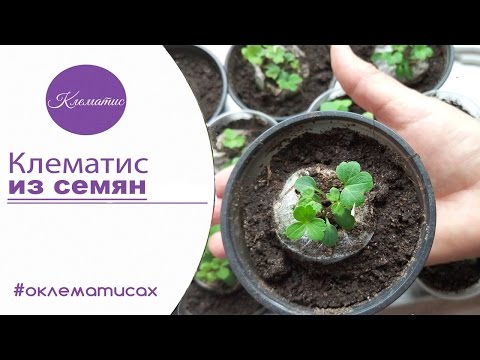

Watch this video on YouTube
Planting clematis in open ground
What time to plant
It is very important to plant clematis in open ground at the right time, and you must carefully choose the right site for this. An area suitable for planting must be protected from drafts. You also need a sunny area, but it will be very good if it is in shade at noon.The soil is suitable for slightly alkaline nutritious loamy soil, it should also be well-drained and fertilized. This plant is recommended to be planted on a mound or an artificial embankment. As a result, a long (about 100 cm) root will not start to rot due to the proximity of groundwater. It is impossible to feed clematis with sour peat or fresh manure. Do not plant a plant next to a fence or building (do not allow water from the roof to fall on clematis), a distance of at least 0.3 m should be maintained between them.
It is possible to plant such a culture in open ground both in autumn and in spring. If you purchased a seedling in a container, then you can plant it in summer, autumn, and spring. If you purchased planting material in late autumn and were late with planting, then it should be stored until spring. To do this, the seedlings are placed in a cool room (no more than 5 degrees), their root system must be covered with a mixture of sand and sawdust, which must be moistened. To restrain the growth of seedlings, it is necessary to regularly pinch.
Before planting, you need to carefully examine the root system of the plant. If it is dry, then it should be immersed in cold water for several hours before planting so that the roots can swell.
Spring planting
If the climate in the region is cool, then clematis is planted in open ground in the spring, or rather, in the last days of April or the first days of May. A spring sapling must have at least one stem.
The size of the planting pit should be 0.6x0.6x0.6 m. At the bottom of the pit, it is necessary to make a drainage layer 10 to 15 centimeters thick, for this it is recommended to use broken brick, crushed stone or perlite. If the soil is poor, then this must be corrected by adding 1 bucket of peat and sand, 2-3 buckets of compost, 150 grams of superphosphate and 400 grams of dolomite flour into it (you need to mix everything very well, while experts recommend fertilizing the soil 1 year before landing). For the stems of the seedlings, it is necessary to install removable supports (if you wish, you can dig in stationary supports), their height should reach 250 cm. The supports are needed to support the plant in strong gusts of wind. On the surface of the drainage layer, it is necessary to pour soil with a mound, on which the seedling should be installed. After its roots are carefully straightened, the pit is filled with a prepared soil mixture, while taking into account that the root collar should be buried 50–100 mm into the soil, the shoot trunk should also be in the ground up to the first internode. The hole should not be completely filled; 8 to 10 centimeters should remain to its upper edge. The planted bush should be watered with 10 liters of water. Then the surface of the excavation near the bush must be covered with a layer of peat. Throughout the spring and summer, the remaining recess should be gradually filled with soil. When planting between plants, you must maintain a distance of at least 100 cm.
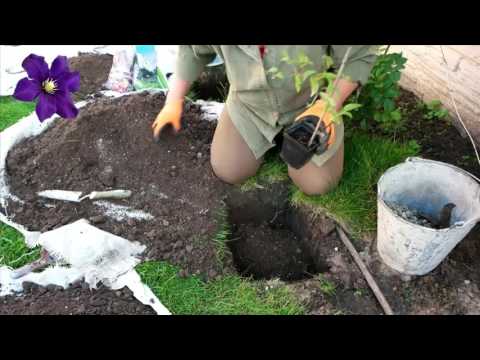

Watch this video on YouTube
Autumn planting
In southern regions with a warm climate, this plant is planted in the autumn, or rather, in September or October, but the seedling must necessarily have developed vegetative buds. It is necessary to plant clematis in the fall in the same way as in the spring, but in this case, the planting hole is completely filled with soil. Then the surface of the soil around the seedling must be covered with a layer of dried foliage, and on top it is covered with any covering material, for example, lutrasil. In spring time, near the plant, it is necessary to remove the soil to a depth of 8 to 10 centimeters; during the summer period, the resulting depression must be gradually filled with soil. Such indentations are made so that it is easier for the stems to break through to the surface of the site.
Caring for clematis in the garden
It is very easy to grow clematis in the garden. This plant is moisture-loving, so it should be watered abundantly at least once every 7 days.In hot summer time, clematis will need to be watered 2 or 3 times a week. For one watering of a young bush, you need to take 1-2 buckets of water, and for an adult - from 2 to 4. It is recommended to dig in several pots around the plant, in the bottom of which there is a hole. During irrigation, water accumulates in them, which will then gradually penetrate into the ground, which is especially good in hot, dry times. If in spring time the soil surface was not covered with a layer of mulch, then it will be necessary to regularly loosen the soil surface 1 day after watering, and all weeds should be pulled out. If you cover the surface of the soil with a layer of mulch (moss, peat or humus), this will significantly reduce the amount of watering, and also slow down the growth of weeds.
During the first year after planting the plant in open ground, too much fertilizer should not be applied to the soil, because the weakened seedling can rot with them. During the period of intensive growth, nitrogen-containing fertilizers must be used to feed clematis, during the formation of buds - potassium fertilizers, at the end of flowering - phosphorus fertilizers. When the plant is cut in the summer, it must be fed with a solution of complete mineral fertilizer (20 grams for 10 liters of water), and also with a copper solution. In spring, every year the bush should be watered with milk of lime (dolomite flour and chalk). During the flowering period, all feeding of clematis must be stopped, otherwise it will lose its activity. If there is a large amount of rain in the summer, then the lower part of the trunk must be covered with wood ash, which will prevent the appearance of rot on the root system of the plant.
Supports for clematis
You can purchase several types of supports for vines, namely: fan structures, arches and pyramids. Any of the designs is suitable for Clematis, but it should be noted that the place where the vine clings to the support should have a diameter of no more than 10-12 mm. It should also be borne in mind that the overgrown clematis is quite heavy, especially when it rains, in this regard, it is necessary to buy a structure that is made of a sufficiently strong material. One great idea is to install a cylinder that should be made of rare metal mesh. The liana should grow inside this structure, which it will gradually cover with its foliage.
Reproduction of clematis
This plant can be grown from seed. You can find information on how to do this above. Also, this vine can be propagated by vegetative methods: dividing the bush, summer and autumn layering, as well as pinning young shoots.
For division, you should choose a bush that is no more than 6 years old, since more mature specimens have a powerful root system, which is very difficult to cope with. The plant must be carefully removed from the soil, then the soil is removed from its root. With the help of a pruner, the bush is cut into several divisions, and each of them should have buds on the root collar.
To obtain cuttings in October, you need to cut off all the foliage from the stems. The faded part should be cut off to the first developed bud. Then the shoots are woven into a bundle and laid in grooves, at the bottom of which there is a layer of peat. The stems fixed in this position must be covered with peat, and from above with soil, which must be tamped. For wintering, Clematis should be covered with dried leaves or spruce branches. As soon as spring comes, you need to start watering the planting site regularly and abundantly. After the shoots appear, the surface of the soil around them must be covered with a layer of mulch (humus or peat). With the onset of the autumn period, most of the young plants can be planted in a permanent place. To exclude injury to the root system, it is necessary to remove sprouts from the soil using a pitchfork. Layers can be laid, if desired, in the summer, however, it should be noted that in this case there is a high probability that the shoots will die in winter.
It is recommended to do the trimming of the stems in the spring. To do this, choose last year's shoots, they must be pinned at the site of the knot in pots filled with loose soil and peat, which should be dug into the ground below the surface of the site. As a result, during watering, the liquid will remain in the pot. As the seedling grows, it is necessary to add soil to the pot, while it should be poured with a mound. Excellent seedlings will be formed in the fall.
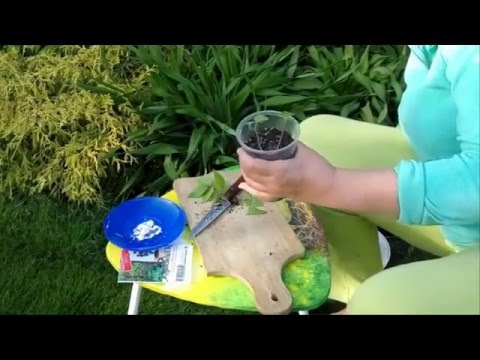

Watch this video on YouTube
Diseases and pests
Most often, such a culture suffers from wilting, which is a fungal disease. The bush loses its tissue elasticity, it begins to fade and dry out. There are several pathogens with similar symptoms, all of them are in the ground and first affect the root system. The best way to prevent is to follow the rules of agricultural technology. The first symptoms of the disease will appear at the beginning of the spring period. In May, the affected areas should be removed, and the bush itself must be shed under the root with a solution of Azocene or Fundazol, the concentration of which should be equal to 2%. If the bush is very badly affected, then it must be dug up along with a lump of earth and burned, and the site should be disinfected with the same means. Azocene and Fundazol will help cure specimens infected with powdery mildew or gray rot.
This plant can also get sick with rust, which is also a fungal disease. In the affected specimens, orange pads are formed on the surface of the stems and leaves in spring. Over time, the foliage changes its color to brown and dries up, deformation of the stems is observed. Infected specimens must be treated with Bordeaux liquid (1–2%), either copper oxychloride or Oxychom.
In the last weeks of the summer period, necrosis of a dark gray color may form on the surface of the stems and foliage, due to which the color of the affected parts changes, and they also become velvety. In the middle of the summer period, the plant may be damaged by ascochitosis, due to which necrotic spots with an irregular shape appear on the foliage. If clematis becomes infected with cylindrosporiasis, then specks of a rich yellow color will appear on the surface of its leaf plates. You can cope with all these diseases with the help of products containing copper, for example, you can use a solution of copper sulfate (1%).
This plant is resistant to viral diseases. However, sucking insects can cause a yellow mosaic of leaves to damage the bush, which has not yet been learned to treat. In this regard, the affected specimen must be dug up and burned. For planting clematis, it is not recommended to choose areas located next to hosta, sweet peas, delphinium, aquilegia, phlox and peony, because these plants are prone to mosaic disease.
Also, such a culture can suffer from leaf or root nematodes. If you are digging up rotten bushes, be sure to do a thorough inspection of their root system. If there are nodules on it, then it is forbidden to plant clematis on this site for several years.
Pruning clematis
You can prune clematis during the period of active growth, as needed, to prolong flowering, and even before winter. It has already been said above that clematis are divided into 3 groups:
- Group A (first group)... Flowers appear on the stems of the last year; therefore, only weak shoots are subject to pruning. Pruning is done in June, when the plant has faded. In late autumn, the bushes need to be highlighted.
- Group B (second group)... Flowers are formed on the shoots of this and last year. Shoots should be shortened to 50–100 cm, leaving 2–5 pairs of buds. Weak stems must be cut to the root. For the winter, it is necessary to remove such a plant from the support, roll it up and carefully put it at the roots.
- Group C (third group)... Flowers appear only on young shoots of this year.Pruning of such a vine is carried out several times during the growing season. In autumn, all stems should be cut to the level of the surface of the plot or slightly higher.
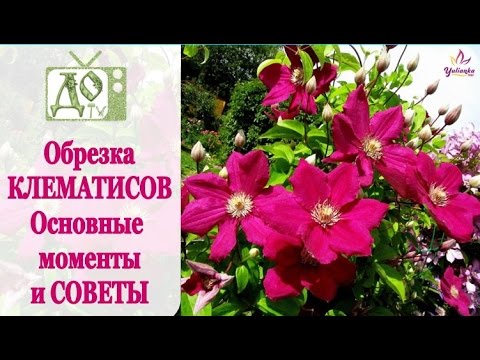

Watch this video on YouTube
Clematis after flowering
The preparation of the plant for winter should be done in late autumn. To do this, all the foliage must be cut off from the bush, and the root collar must be treated with a solution of copper sulfate (2%). Then, in dry weather, 1 bucket of humus should be poured under the base of the plant in the center of the bush. Then you need to huddle the bush to a height of 10 to 15 centimeters, for this use a mixture of wood ash with sand (250 grams of ash are taken for 1 bucket of sand). If the plant needs shelter, then it is covered with a dry method. To do this, the stems are bent (or you can twist them and put them on the base), then they are covered with dry foliage, spruce branches or crushed foam. From above, they should be covered with a wooden box, because there should be air around the bush. The box is covered from above with any covering material that does not allow water to pass through, for example, roofing material, roofing felt, etc. In order for the covering material not to be blown off, it must be pressed in the corners with stones or bricks, and covered with a layer of peat or earth on top, the thickness of which should be from 0 , 2 to 0.25 m. In spring, peat and covering material are removed first. The foliage or spruce branches are removed only when the return frosts are left behind. The stems must be carefully lifted. After they are straightened, they are distributed over the supports.
Types and varieties of clematis with photos and names
There are many classifications of clematis. So, they are divided into groups of M.A. Beskaravaynaya, which take into account the origin of the species on the maternal line, the taxonomic system of M. Tamura is used, as well as the classification of L. Bailey, A. Raider, V. Matthews and others.
Beginners, as well as amateur gardeners, for the most part use the simplest classifications of clematis according to the size of flowers: small-flowered, medium-flowered and large-flowered. However, the most convenient classification system is as follows:
- group A - flowering is observed on last year's shoots;
- group B - flowering is observed on the shoots of the past and current year;
- group C - flowering is observed on the shoots of the current year.
Below, these groups will be considered in more detail, as well as the clematis varieties related to them.
First group A
Alpine Clematis (Alpina)
The height of such a vine is about 300 cm. Leathery leaf plates are large. Tubular small flowers are blue in color. Flowering begins in August. In some cases, it is also used as a curb plant. Popular varieties:
- Artagena Franchi... It reaches a height of 200–240 cm. Bell-shaped flowers are directed downward. They are blue and have a white center.
- Albina plena... Plant height is about 280 cm. Flowers are double white. Flowering occurs in May – June.
- Pamela jackman... The stems can reach 200-300 cm in length. The drooping flowers have a blue-violet color, in length they reach 60 to 70 mm. Blooms in April – June. Re-flowering is observed from the middle to the end of the summer period, it is less luxuriant than the first.
Flowering Clematis (Florida)
A woody liana, reaching a height of more than 300 cm. Fragrant single flowers are relatively large, as a rule, they are painted in light color shades. There are bicolor varieties. The most popular varieties:
- Vyvyan pennell... The plant reaches a height of about 350 cm. Double lilac flowers in diameter reach from 12 to 15 centimeters.
- Kid... The height of the bush is about 100 cm. The flowers are cruciform, pale purple in color with a blue tint, in diameter they reach from 10 to 14 centimeters.
- Joan of Arc... Terry, fragrant white flowers have a compact size, but they look large against the background of a small bush. This clematis is resistant to frost, direct sunlight, shade and most diseases.
Mountain Clematis (Montana)
This giant liana reaches a height of 9 meters. Small sharp leaf plates are collected in small bunches of 5 pieces. White flowers are located on long pedicels, they have yellow stamens, and in diameter they reach 40-50 mm. Does not have high winter hardiness. Popular varieties:
- Rubens... This woody liana is characterized by rapid growth; it reaches a length of about 6 meters. Pointed triple leaf plates have an oval shape and a bronze sheen. Pink-red open flowers are collected in 3-5 pieces. They reach 60 mm in diameter. This light-loving plant has a lush flowering.
- Montana Grandiflora... In this liana, shoots can be up to 5 meters long. Adjacent trifoliate leaf plates are arranged in bundles. Medium-sized open flowers about 50 mm in diameter have a very delicate aroma. They are collected in bunches in several pieces. The sepals are pink-white or white, and the anthers are yellowish. Flowering occurs in May – June.
Second group B
Woolly Clematis (Lanuginoza)
In length, this shrub vine reaches about 250 cm. Very spectacular single flowers reach about 0.2 m in diameter, they can be painted in blue, white or pink. The first flowering occurs in May-June on last year's shoots, and the second - in the last summer weeks, but already on the shoots of the current season. The most popular varieties are:
- Madame Le Cultre... The length of the shoots can vary from 250 to 300 cm. Whole or lobed leaf plates can be trifoliate or simple. In diameter, the flowers reach 14 to 20 centimeters, they have white sepals and light-colored anthers. Flowering begins in July. The plant has medium frost resistance.
- Hybrida Sieboldii... The stems are about 300 cm long. The flowers reach 16 centimeters across. The sepals are pale lilac in color and have a dark edge, the anthers are brownish red. Bloom is observed in July – September.
- Lawsoniana... In length, the stems of this shrub liana can reach about 300 cm. The leaf plates can be simple, but most often they are trifoliate, the leaves have an oval shape. The buds are looking up. In diameter, the fragrant flowers reach 18 centimeters. The color of the sepals is violet-lilac, while in the middle there is a strip of a dark shade, the anthers are purple. Flowering occurs in May – June, with weaker re-flowering sometimes observed in autumn.
Spreading Clematis (Patens)
The stems of this shrub vine can be about 350 cm long. Large flowers reach 15 centimeters or more in diameter. They can be found in a wide variety of colors from dark blue to white. There are bicolor varieties. Flowers can be star-shaped, simple or double-shaped. Flowering is observed in May – June on last year's shoots. Sometimes there is repeated flowering in autumn, but already on the shoots of the current season. All varieties have low winter hardiness:
- Joan Pikton... The stems can be about 300 cm long. The flowers are large, so they can reach 22 centimeters across. They are painted in a pale lilac color with a lilac shade, while in the middle of the petal there is a strip of light color. The petals have a wavy edge, the anthers are colored red. The bloom is very lush.
- Multi Blue... The height of the liana can reach up to 250 cm. The purple-blue double flowers in diameter reach about 14 centimeters. Along the stem, they are placed in several tiers. Blooming is observed in June – August.
Third group C
Clematis of the Jacquemann group
These plants were obtained by crossing Clematis Viticella with Clematis Lanuginosa. In most cases, this group is represented by large shrub lianas, the length of the stems of which can vary from 4 to 6 meters. The root system is very well developed. The composition of the pinnately complex leaf plates includes from 3 to 5 large leaves. The buds are elongated. Flowers can be collected in three pieces or be single.They are open, odorless and directed to the side and upward. They can be painted in a variety of colors, but not white. Flowers reach 20 centimeters across. But there are varieties, the diameter of the flowers in which does not exceed eight centimeters. Long and lush flowering is observed on the shoots of the current season. In winter, they should be cut to the level of the surface of the site, or the shoots are shortened to 3-5 pairs of buds. The most popular varieties are:
- Rouge Cardinal... The length of the stems of such a vine can vary from 200 to 250 cm. The leaf plates are trifoliate. The cross-shaped open flowers reach about 15 centimeters in diameter. Sepals are velvety, dark purple in color, anthers are pale purple. Bloom is observed in July – September. Possesses moderate frost resistance. This variety has many horticultural awards.
- Star of india... The stems of this shrub vine can reach about 300 cm in length. The complex leaf plates include from 3 to 5 whole or lobed leaves of an oval-pointed shape. The opened flowers reach 15 centimeters across. Rhomboid sepals have a deep purple color, a purple strip runs along the middle, anthers are light in color. Very lush bloom is observed from mid to late summer.
- Gipsy queen... The length of the shoots of such a shrub vine is about 350 cm. In one bush, there are about 15 stems. Complex leaf plates. The buds are raised up. The opened flowers reach 15 centimeters across. The velvet wide sepals are painted in a deep purple color, they practically do not fade in the sun. Anthers have a maroon color, while the pollen is also colored. Lush flowering, observed from mid-summer to the onset of frost. Differs in shade tolerance, about 20 flowers are formed on one stem. It is resistant to fungal diseases.
- Bella... The stems are about 200 cm long. Waxy star-shaped flowers reach 10-15 centimeters across. At first, they are yellowish in color, but then they become snow-white. Such a plant is resistant to frost and fungal diseases. Bloom is observed in July – September.
Clematis violet (Viticella)
In this species, flowers are painted in a variety of shades of purple. The flowers are simple, drooping are found, in diameter they can reach 10–20 centimeters. The length of the stems does not exceed 350 cm, while they are fast growing. Flowering occurs in June – September. Varieties:
- Ville de Lyon... This liana is shrub. In one bush, there are about 15 dark brown stems, which can be up to 350 cm long. The complex leaf plates include from 3 to 5 lobed or whole leaves, yellowing and drying at the base of the shoots. The buds look up, the peduncles are long. The open flowers reach 10 to 15 centimeters across. The carmine-red sepals are quite wide; in summer they fade in the sun. Anthers have a rich yellow color. Lush flowering, about 15 flowers are formed on each stem.
- Viola... The length of the stems is about 250 cm. The leaf plates are trifoliate. Lush and long blooming is observed in July – October. The disc-shaped open flowers are outwardly similar to the propeller, in diameter they can reach from 10 to 14 centimeters. On the surface of the dark purple sepals, lilac veins are clearly visible, the color of the anthers is yellowish.
- Polish spirit... The stems of this vine can reach 400 cm in length. A large number of lilac-lilac flowers grow on them, reaching about 8 centimeters in diameter. Flowering is observed from the last days of June until the onset of frost.
Whole-leaf Clematis (Integrifolia)
It is a climbing shrub that does not cling to a support. In height, such clematis reaches no more than 250 cm. Bell-shaped drooping flowers can be painted pink, blue, red, purple or blue. The most popular varieties are:
- Clematis Durandii (Clematis Duran)... It is one of the most beautiful large-flowered species that are hybrids. The height of such a climbing shrub is about 200 cm. There are about 15 brown stems in one bush. Dense, one-piece, simple oval-shaped leaf plates are resistant to direct sunlight. The drooping flowers reach 12 centimeters in diameter. The sepals are colored bright blue or deep purple, they fade in the sun, the color of the anthers is yellowish. About 15 flowers are formed on one stem. Flowering is observed in July – October.
- Vyarava... The stems are about 250 cm long. In diameter, the stellate flowers reach 12-16 centimeters, from the inside they are lavender, along the petals there is a strip of burgundy color. Their outer surface is even lighter in lilac shade, while the median strip also has a paler color. Flowering ends with frost.
- Memory of the heart... The length of the stems in this shrub varies from 100 to 200 cm. The drooping bell-shaped flowers reach 5 to 9 centimeters in diameter. Lush bloom is observed in July – October (before frost).
Clematis pungent (small-flowered)
It is a fast-growing vine with small, fragrant white flowers. The stems are about 5 meters long. Complicated feathery leaf plates are dark green in color. The inflorescences consist of cruciform flowers. Blooming is observed in July – August.
Clematis Tangut
This tall vine is fast growing. Small bell-shaped flowers are yellow in color. You can collect seeds from this plant. It is highly resistant to frost, so you do not need to cover it for the winter.
The above are the main species that breeders use in their work, trying to get new, even more beautiful varieties.


Watch this video on YouTube

